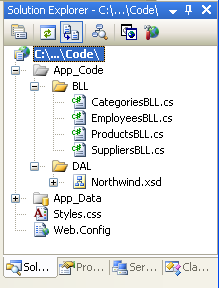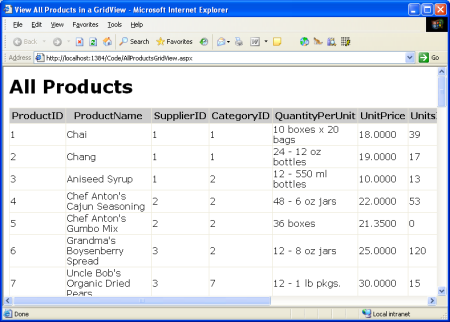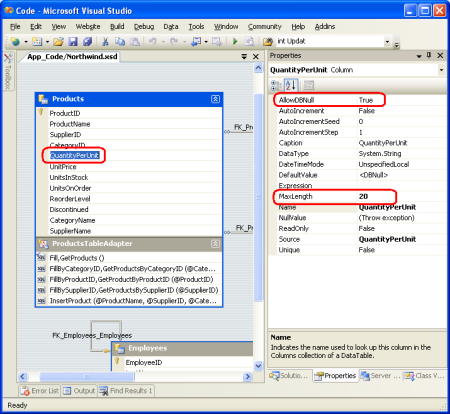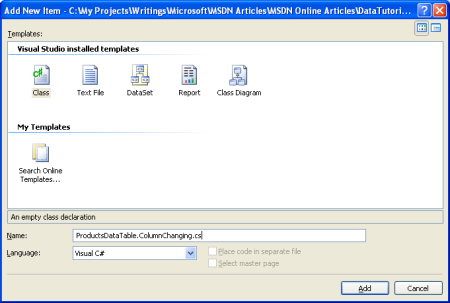您好,登錄后才能下訂單哦!
您好,登錄后才能下訂單哦!
這篇文章給大家介紹怎么在ASP.NET 2.0中創建一個業務邏輯層,內容非常詳細,感興趣的小伙伴們可以參考借鑒,希望對大家能有所幫助。
第一步:創建BLL類
我們的BLL由4個類組成,每一個BLL類都對應DAL中的一個TableAdapter,它們都從各自的TableAdapter中得到讀取、插入、修改以及刪除等方法以應用合適的業務規則。
為了更加清晰的區分DAL和BLL的類,我們在App_Code文件夾中建立兩個子文件夾,分別命名為DAL和BLL。你僅僅需要在解決方案瀏覽器(Solution Explorer)中右鍵點擊App_Code文件夾,并選擇新建文件夾(New Folder),就可以創建新的子文件夾了。建好了這兩個文件夾之后,把第一節中所創建的類型化數據集(Typed DataSet)移到DAL文件夾中。
然后,在BLL文件夾中創建4個類文件。同樣,你僅僅需要在解決方案瀏覽器(Solution Explorer)中右鍵點擊BLL文件夾,并選擇新建項目(New Item),然后在彈出的對話框中選擇類模板(Class template)就可以創建新的類文件了。將這四個文件分別命名為ProductsBLL、CategoriesBLL、SuppliersBLL以及EmployeesBLL。

圖二:在BLL文件夾中添加4個新的類
接下來,讓我們來給這些新建的類加上一些方法,簡單的將第一節中的TableAdapter中的那些方法包裝起來就行了。現在,這些方法將只能直接使用DAL中的那些方法,我們等會再來給他們加上一些業務邏輯。
注意:如果你使用的是Visual Studio 標準版或以上版本(也就是說,你不是用的Visual Web Developer),那么你還可以使用
在ProductsBLL類中,我們一共需要為其添加7個方法:
GetProducts() – 返回所有的產品
GetProductByProductID(productID) – 返回指定ProductID的產品
GetProductsByCategoryID(categoryID) –返回指定分類的產品
GetProductsBySupplier(supplierID) –返回指定供應商的產品
AddProduct(productName, supplierID, categoryID, quantityPerUnit, unitPrice, unitsInStock, unitsOnOrder, reorderLevel, discontinued) – 向數據庫中添加一條產品信息,并返回新添加的產品的ProductID
UpdateProduct(productName, supplierID, categoryID, quantityPerUnit, unitPrice, unitsInStock, unitsOnOrder, reorderLevel, discontinued, productID) – 更新一個數據庫中已經存在的產品,如果剛好更新了一條記錄,則返回true,否則返回false
DeleteProduct(productID) – 刪除指定ProductID的產品
using System;
using System.Data;
using System.Configuration;
using System.Web;
using System.Web.Security;
using System.Web.UI;
using System.Web.UI.WebControls;
using System.Web.UI.WebControls.WebParts;
using System.Web.UI.HtmlControls;
using NorthwindTableAdapters;
[System.ComponentModel.DataObject]
public class ProductsBLL
{
private ProductsTableAdapter _productsAdapter = null;
protected ProductsTableAdapter Adapter
{
get {
if (_productsAdapter == null)
_productsAdapter = new ProductsTableAdapter();
return _productsAdapter;
}
}
[System.ComponentModel.DataObjectMethodAttribute(System.ComponentModel.DataObjectMethodType.Select, true)]
public Northwind.ProductsDataTable GetProducts()
{
return Adapter.GetProducts();
}
[System.ComponentModel.DataObjectMethodAttribute(System.ComponentModel.DataObjectMethodType.Select, false)]
public Northwind.ProductsDataTable GetProductByProductID(int productID)
{
return Adapter.GetProductByProductID(productID);
}
[System.ComponentModel.DataObjectMethodAttribute(System.ComponentModel.DataObjectMethodType.Select, false)]
public Northwind.ProductsDataTable GetProductsByCategoryID(int categoryID)
{
return Adapter.GetProductsByCategoryID(categoryID);
}
[System.ComponentModel.DataObjectMethodAttribute(System.ComponentModel.DataObjectMethodType.Select, false)]
public Northwind.ProductsDataTable GetProductsBySupplierID(int supplierID)
{
return Adapter.GetProductsBySupplierID(supplierID);
}
[System.ComponentModel.DataObjectMethodAttribute(System.ComponentModel.DataObjectMethodType.Insert, true)]
public bool AddProduct(string productName, int? supplierID, int? categoryID, string quantityPerUnit,
decimal? unitPrice, short? unitsInStock, short? unitsOnOrder, short? reorderLevel,
bool discontinued)
{
// 新建一個ProductRow實例
Northwind.ProductsDataTable products = new Northwind.ProductsDataTable();
Northwind.ProductsRow product = products.NewProductsRow();
product.ProductName = productName;
if (supplierID == null) product.SetSupplierIDNull(); else product.SupplierID = supplierID.Value;
if (categoryID == null) product.SetCategoryIDNull(); else product.CategoryID = categoryID.Value;
if (quantityPerUnit == null) product.SetQuantityPerUnitNull(); else product.QuantityPerUnit = quantityPerUnit;
if (unitPrice == null) product.SetUnitPriceNull(); else product.UnitPrice = unitPrice.Value;
if (unitsInStock == null) product.SetUnitsInStockNull(); else product.UnitsInStock = unitsInStock.Value;
if (unitsOnOrder == null) product.SetUnitsOnOrderNull(); else product.UnitsOnOrder = unitsOnOrder.Value;
if (reorderLevel == null) product.SetReorderLevelNull(); else product.ReorderLevel = reorderLevel.Value;
product.Discontinued = discontinued;
// 添加新產品
products.AddProductsRow(product);
int rowsAffected = Adapter.Update(products);
// 如果剛好新增了一條記錄,則返回true,否則返回false
return rowsAffected == 1;
}
[System.ComponentModel.DataObjectMethodAttribute(System.ComponentModel.DataObjectMethodType.Update, true)]
public bool UpdateProduct(string productName, int? supplierID, int? categoryID, string quantityPerUnit,
decimal? unitPrice, short? unitsInStock, short? unitsOnOrder, short? reorderLevel,
bool discontinued, int productID)
{
Northwind.ProductsDataTable products = Adapter.GetProductByProductID(productID);
if (products.Count == 0)
// 沒有找到匹配的記錄,返回false
return false;
Northwind.ProductsRow product = products[0];
product.ProductName = productName;
if (supplierID == null) product.SetSupplierIDNull(); else product.SupplierID = supplierID.Value;
if (categoryID == null) product.SetCategoryIDNull(); else product.CategoryID = categoryID.Value;
if (quantityPerUnit == null) product.SetQuantityPerUnitNull(); else product.QuantityPerUnit = quantityPerUnit;
if (unitPrice == null) product.SetUnitPriceNull(); else product.UnitPrice = unitPrice.Value;
if (unitsInStock == null) product.SetUnitsInStockNull(); else product.UnitsInStock = unitsInStock.Value;
if (unitsOnOrder == null) product.SetUnitsOnOrderNull(); else product.UnitsOnOrder = unitsOnOrder.Value;
if (reorderLevel == null) product.SetReorderLevelNull(); else product.ReorderLevel = reorderLevel.Value;
product.Discontinued = discontinued;
// 更新產品記錄
int rowsAffected = Adapter.Update(product);
// 如果剛好更新了一條記錄,則返回true,否則返回false
return rowsAffected == 1;
}
[System.ComponentModel.DataObjectMethodAttribute(System.ComponentModel.DataObjectMethodType.Delete, true)]
public bool DeleteProduct(int productID)
{
int rowsAffected = Adapter.Delete(productID);
// 如果剛好刪除了一條記錄,則返回true,否則返回false
return rowsAffected == 1;
}
}GetProducts、GetProductByProductID、GetProductsByCategoryID以及 GetProductBySuppliersID等方法都僅僅是簡簡單單的直接調用DAL中的方法來返回數據。不過在有的情況下,我們還可能需要給它們實現一些業務規則(比如說授權規則,不同的用戶或不用角色應該可以看到不同的數據),現在我們簡單的將它們做成這樣就可以了。那么,對于這些方法來說,BLL僅僅是作為表示層與DAL之間的代理。
AddProduct和UpdateProduct這兩個方法都使用參數中的那些產品信息去添加或是更新一條產品記錄。由于Product表中有許多字段都允許空值(CategoryID、SupplierID、UnitPrice……等等),所以AddProduct和UpdateProduct中相應的參數就使用nullable types。Nullable types是.NET 2.0中新提供的一種用于標明一個值類型是否可以為空的技術。在C#中,你可以在一個允許為空的值類型后面加上一個問號(比如,int? x;)。關于Nullable Types的詳細信息,你可以參考C# Programming Guide。
由于插入、修改和刪除可能不會影響任何行,所以這三種方法均返回一個bool值用于表示操作是否成功。比如說,頁面開發人員使用一個并不存在的ProductID去調用DeleteProduct,很顯然,提交給數據庫的DELETE語句將不會有任何作用,所以DeleteProduct會返回false。
注意:當我們在添加或更新一個產品的詳細信息時,都是接受由產品信息組成的一個標量列表,而不是直接接受一個ProductsRow實例。因為ProductsRow是繼承于ADO.NET的DataRow,而DataRow沒有默認的無參構造函數,為了創建一個ProductsRow的實例,我們必須先創建一個ProductsDataTable的實例,然后調用它的NewProductRow方法(就像我們在AddProduct方法中所做的那樣)。不過,當我在使用ObjectDataSource來插入或更新時,這樣做的缺點就會暴露出來了。簡單的講,ObjectDataSource會試圖為輸入的參數創建一個實例,如果BLL方法希望得到一個ProductsRow,那么ObjectDataSource就將會試圖去創建一個,不過很顯然,這樣的操作一定會失敗,因為沒有一個默認的無參構造函數。這個問題的詳細信息,可以在ASP.NET論壇的以下兩個帖子中找到: Updating ObjectDataSources with Strongly-Typed DataSets、Problem With ObjectDataSource and Strongly-Typed DataSet。
之后,在AddProduct和UpdateProduct中,我們創建了一個ProductsRow實例,并將傳入的參數賦值給它。當給一個DataRow的DataColumns賦值時,各種字段級的有效性驗證都有可能會被觸發。因此,我們應該手工的驗證一下傳入的參數以保證傳遞給BLL方法的數據是有效的。不幸的是,Visual Studio生成的強類型數據集(strongly-typed DataRow)并沒有使用nullable values。要表明DataRow中的一個DataColumn可以接受空值,我們就必須得使用SetColumnNameNull方法。
在UpdateProduct中,我們先使用GetProductByProductID(productID)方法將需要更新的產品信息讀取出來。這樣做好像沒有什么必要,不過我們將在之后的關于并發優化(Optimistic concurrency)的課程中證明這個額外的操作是有它的作用的。并發優化是一種保證兩個用戶同時操作一個數據而不會發生沖突的技術。獲取整條記錄同時也可以使創建一個僅更新DataRow的一部分列的方法更加容易,我們可以在SuppliersBLL類中找到這樣的例子。
最后,注意我們在ProductsBLL類上面加上了DataObject 標簽(就是在類聲明語句的上面的[System.ComponentModel.DataObject]),各方法上面還有DataObjectMethodAttribute 標簽。DataObject標簽把這個類標記為可以綁定到一個ObjectDataSource控件,而DataObjectMethodAttribute則說明了這個方法的目的。我們將在后面的教程中看到,ASP.NET 2.0的ObjectDataSource使從一個類中訪問數據更加容易。為了ObjectDataSource向導能夠對現有的類進行合適的篩選,在類列表中默認僅顯示標記為DataObject的類。當然,其實ProductsBLL類就算沒有這個標簽也可以工作,但是加上它可以使我們在ObjectDataSource向導中的操作更加輕松和心情愉快。
添加其他的類
完成了ProductsBLL類之后,我們還要添加一些為categories、suppliers和employees服務的類。讓我們花點時間來創建下面的類,根據上面的例子來做就是了:
·CategoriesBLL.cs
GetCategories()
GetCategoryByCategoryID(categoryID)
·SuppliersBLL.cs
GetSuppliers()
GetSupplierBySupplierID(supplierID)
GetSuppliersByCountry(country)
UpdateSupplierAddress(supplierID, address, city, country)
·EmployeesBLL.cs
GetEmployees()
GetEmployeeByEmployeeID(employeeID)
GetEmployeesByManager(managerID)
SuppliersBLL類中的UpdateSupplierAddress方法是一個值得注意的東西。這個方法提供了一個僅僅更新供應商地址信息的接口。它首先根據指定的SupplierID讀出一個SupplierDataRow(使用GetSupplierBySupplierID方法),設置其關于地址的所有屬性,然后調用SupplierDataTable的Update方法。UpdateSupplierAddress方法的代碼如下所示:
[System.ComponentModel.DataObjectMethodAttribute(System.ComponentModel.DataObjectMethodType.Update, true)]
public bool UpdateSupplierAddress(int supplierID, string address, string city, string country)
{
Northwind.SuppliersDataTable suppliers = Adapter.GetSupplierBySupplierID(supplierID);
if (suppliers.Count == 0)
// 沒有找到匹配的項,返回false
return false;
else
{
Northwind.SuppliersRow supplier = suppliers[0];
if (address == null) supplier.SetAddressNull(); else supplier.Address = address;
if (city == null) supplier.SetCityNull(); else supplier.City = city;
if (country == null) supplier.SetCountryNull(); else supplier.Country = country;
// 更新供應商的關于地址的信息
int rowsAffected = Adapter.Update(supplier);
// 如果剛好更新了一條記錄,則返回true,否則返回false
return rowsAffected == 1;
}
}可以從頁面頂部的鏈接處下載BLL類的完整代碼。
第二步:通過BLL類訪問類型化數據集
在本教程的第一節中,我們給出了直接使用類型化數據集的例子,不過在我們添加了BLL類之后,表示層就可以通過BLL來工作了。在本教程的第一節中的AllProducts.aspx的例子中,ProductsTableAdapter用于將產品列表綁定到GridView上,代碼如下所示:
ProductsTableAdapter productsAdapter = new ProductsTableAdapter(); GridView1.DataSource = productsAdapter.GetProducts(); GridView1.DataBind();
要使用新的BLL類,我們所需要做的僅僅是簡單的修改一下第一行代碼。用ProductBLL對象來代替 ProductsTableAdapter即可:
ProductsBLL productLogic = new ProductsBLL(); GridView1.DataSource = productLogic.GetProducts(); GridView1.DataBind();
BLL類也可以通過使用ObjectDataSource來清晰明了的訪問(就像類型化數據集一樣)。我們將在接下來的教程中詳細的討論ObjectDataSource。

圖三:GridView中顯示的產品列表
第三步:給DataRow添加字段級驗證
字段級驗證是指在插入或更新時檢查業務對象所涉及到的所有屬性值。拿產品來舉個例,某些字段級的驗證規則如下所示:
·ProductName字段不得超過40個字符
·QuantityPerUnit字段不得超過20個字符
·ProductID、ProductName以及Discontinued字段是必填的,而其他字段則是可填可不填的
·UnitPrice、UnitsInStock、UnitsOnOrder以及ReorderLevel字段不得小于0
這些規則可以或者說是應該在數據庫層被描述出來。ProductName和QuantityPerUnit字段上的字符數限制可以通過Products表中相應列的數據類型來實現(分別為nvarchar(40) and nvarchar(20))。字段“是否必填”可以通過將數據庫中表的相應列設置為“允許為NULL”來實現。為了保證UnitPrice、UnitsInStock、UnitsOnOrder以及ReorderLevel字段的值不小于0,可以分別在它們的相應列上加一個約束。
除了在數據庫中應用了這些規則之外,它們同時也將被其應用在DataSet上。事實上,字段長度和是否允許為空等信息已經被應用到了各DataTable的DataColumn集合中。我們可以在數據集設計器(DataSet Designer)中看到已經存在的字段級驗證,從某個DataTable中選擇一個字段,然后在屬性窗口中就可以找到了。如圖四所示,ProductDataTable中的QuantityPerUnit字段允許空值并且最大長度為20各字符。如果我們試圖給某個ProductsDataRow的QuantityPerUnit屬性設置一個長度大于20個字符的字符串,將會有一個ArgumentException被拋出。

圖四:DataColumn提供了基本的字段級驗證
不幸的是,我們不能通過屬性窗口指定一個邊界檢查,比如UnitPrice的值不能小于0。為了提供這樣的字段級驗證,我們需要為DataTable的ColumnChanging事件建立一個Event Handler。正如上一節教程中所提到的那樣,由類型化數據集創建的DataSet、DataTable還有DataRow對象可以通過partial類來進行擴展。使用這個技術,我們可以為ProductDataTable創建一個ColumnChanging的Event Handler。我們先在App_Code文件夾中新建一個名為ProductsDataTable.ColumnChanging.cs的類文件,如下圖所示。

圖五:在App_Code文件夾中添加新類
然后,給ColumnChanging事件創建一個Event handler,以保證UnitPrice、UnitsInStock、UnitsOnOrder以及ReorderLevel字段的值不小于0。如果這些列的值超出范圍就拋出一個ArgumentException。
public partial class Northwind
{
public partial class ProductsDataTable
{
public override void BeginInit()
{
this.ColumnChanging += ValidateColumn;
}
void ValidateColumn(object sender, DataColumnChangeEventArgs e)
{
if(e.Column.Equals(this.UnitPriceColumn))
{
if(!Convert.IsDBNull(e.ProposedValue) && (decimal)e.ProposedValue < 0)
{
throw new ArgumentException("UnitPrice cannot be less than zero", "UnitPrice");
}
}
else if (e.Column.Equals(this.UnitsInStockColumn) ||
e.Column.Equals(this.UnitsOnOrderColumn) ||
e.Column.Equals(this.ReorderLevelColumn))
{
if (!Convert.IsDBNull(e.ProposedValue) && (short)e.ProposedValue < 0)
{
throw new ArgumentException(string.Format("{0} cannot be less than zero", e.Column.ColumnName), e.Column.ColumnName);
}
}
}
}
}第四步:給BLL類添加業務規則
除了字段級的驗證,可能還有一些不能在單個列中表示的包含不同實體或概念的更高級的業務規則,比如:
·如果一個產品被標記為“停用”,那么它的單價就不能被修改
·一個雇員的居住地必須與他(她)的主管的居住地相同
·如果某個產品是某供應商唯一提供的產品,那么這個產品就不能被標記為“停用”
BLL類應該保證始終都驗證應用程序的業務規則。這些驗證可以直接的添加到應用他們的方法中。
想象一下,我們的業務規則表明了如果一個產品是給定的供應商的唯一產品,那么它就不能被標記為“停用”。也就是說,如果產品X是我們從供應商Y處購買的唯一一個產品,那么我們就不能將X標記為停用;然而,如果供應商Y提供給我們的一共有3樣產品,分別是A、B和C,那么我們可以將其中任何一個或者三個全部都標記為“停用”。挺奇怪的業務規則,是吧?但是商業上的規則通常就是跟我們平常的感覺不太一樣。
要在UpdateProducts方法中應用這個業務規則,那么我們就應該先檢查Discontinued是否被設置為true。假如是這樣的話,那么我們應該先調用GetProductsBySupplierID來看看我們從這個供應商處一共購買了多少產品。如果我們僅僅從這個供應商處購買了這一個產品,那么我們就拋出一個ApplicationException。
public bool UpdateProduct(string productName, int? supplierID, int? categoryID, string quantityPerUnit,
decimal? unitPrice, short? unitsInStock, short? unitsOnOrder, short? reorderLevel,
bool discontinued, int productID)
{
Northwind.ProductsDataTable products = Adapter.GetProductByProductID(productID);
if (products.Count == 0)
// 沒有找到匹配項,返回false
return false;
Northwind.ProductsRow product = products[0];
// 業務規則檢查 – 不能停用某供應商所提供的唯一一個產品
if (discontinued)
{
// 獲取我們從這個供應商處獲得的所有產品
Northwind.ProductsDataTable productsBySupplier = Adapter.GetProductsBySupplierID(product.SupplierID);
if (productsBySupplier.Count == 1)
// 這是我們從這個供應商處獲得的唯一一個產品
throw new ApplicationException("You cannot mark a product as discontinued if its the only product purchased from a supplier");
}
product.ProductName = productName;
if (supplierID == null) product.SetSupplierIDNull(); else product.SupplierID = supplierID.Value;
if (categoryID == null) product.SetCategoryIDNull(); else product.CategoryID = categoryID.Value;
if (quantityPerUnit == null) product.SetQuantityPerUnitNull(); else product.QuantityPerUnit = quantityPerUnit;
if (unitPrice == null) product.SetUnitPriceNull(); else product.UnitPrice = unitPrice.Value;
if (unitsInStock == null) product.SetUnitsInStockNull(); else product.UnitsInStock = unitsInStock.Value;
if (unitsOnOrder == null) product.SetUnitsOnOrderNull(); else product.UnitsOnOrder = unitsOnOrder.Value;
if (reorderLevel == null) product.SetReorderLevelNull(); else product.ReorderLevel = reorderLevel.Value;
product.Discontinued = discontinued;
// 更新產品記錄
int rowsAffected = Adapter.Update(product);
// 如果剛好更新了一條記錄,則返回true,否則返回false
return rowsAffected == 1;
}在表示層中響應驗證錯誤
當我們從表示層中調用BLL時,我們可以決定是否要處理某個可能會被拋出的異常或者讓它直接拋給ASP.NET(這樣將會引發HttpApplication的出錯事件)。在使用BLL的時候,如果要以編程的方式處理一個異常,我們可以使用try...catch塊,就像下面的示例一樣:
ProductsBLL productLogic = new ProductsBLL();
// 更新ProductID為1的產品信息
try
{
// 這個操作將會失敗,因為我們試圖使用一個小于0的UnitPrice
productLogic.UpdateProduct("Scott's Tea", 1, 1, null, -14m, 10, null, null, false, 1);
}
catch (ArgumentException ae)
{
Response.Write("There was a problem: " + ae.Message);
}我們將在后面的教程中看到,當通過一個數據Web控件(data Web Control)來進行插入、修改或刪除操作數據時,處理從BLL中拋出的異常可以直接在一個Event Handler中進行,而不需要使用try…catch塊來包裝代碼。
關于怎么在ASP.NET 2.0中創建一個業務邏輯層就分享到這里了,希望以上內容可以對大家有一定的幫助,可以學到更多知識。如果覺得文章不錯,可以把它分享出去讓更多的人看到。
免責聲明:本站發布的內容(圖片、視頻和文字)以原創、轉載和分享為主,文章觀點不代表本網站立場,如果涉及侵權請聯系站長郵箱:is@yisu.com進行舉報,并提供相關證據,一經查實,將立刻刪除涉嫌侵權內容。